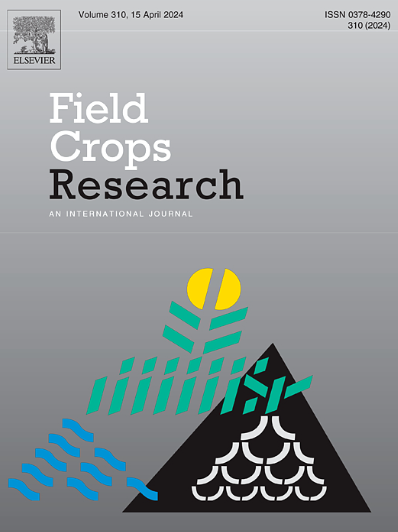Intercrop overyielding is maintained under estimated water and nitrogen stress in maize-cowpea on-farm trials in semi-arid Zimbabwe
IF 5.6
1区 农林科学
Q1 AGRONOMY
引用次数: 0
Abstract
Problem
Semi-arid regions of sub-Saharan Africa are characterized by highly variable rainfall and low inherent soil fertility. Maize-cowpea intercropping may offer the prospect of increasing and stabilizing crop productivity in these regions. However, the performance of such cropping systems often varies considerably in space and time.
Objective
The main objective of the study was to understand how farmer context and rainfall variability influence the performance of maize-cowpea intercropping, using on-farm field experiments together with soil-crop model simulations to compute water and nitrogen stress.
Methods
The data used in this study was generated from twelve on-farm trials during two cropping seasons (2021/22 and 2022/23) in semi-arid Zimbabwe. Three maize (Zea mays L.) varieties, one cowpea (Vigna unguiculata (L.) Walp.) variety and two cropping systems - either sole or intercropped - were tested. The STICS soil-crop model was parameterized to reproduce crop growth in the on-farm trials and compute water and nitrogen (N) stresses. Linear mixed-effects models were used to assess the impact of experimental treatments and simulated water and N stresses on intercropping performance.
Results
The Partial Land Equivalent Ratio (pLER – the ratio of intercropped productivity over sole crop productivity) for maize and cowpea greatly varied across farms and crop types. Maize variety did not significantly impact the pLER of maize and cowpea. Water stress and nitrogen (N) stress simulated by the model were significant predictors of variations in pLER: maize pLER for aboveground biomass significantly decreased with increasing simulated water stress, and maize pLER for grain yield significantly decreased with increased simulated N stress. Yet, average LER remained above one, regardless of the water or N stress on maize, because of a greater contribution of cowpea to LER when water and N stress on maize was high. Late planting was found to exacerbate maize water stress, while low total nitrogen in the top soil was significantly correlated with maize nitrogen stress.
Conclusion
Our study reveals that the production benefits of maize-cowpea intercropping can be maintained, in conditions of high water and nitrogen stress in multi-year and multi-location on-farm experiments.
Implications
Our findings confirm the assumption that intercropping is a useful approach to intensify and stabilize grain and fodder production in smallholder mixed crop-livestock farming systems in semi-arid environments.
在半干旱的津巴布韦进行的玉米-豇豆田间试验中,在估计的水分和氮胁迫下,间作超产得以维持
问题撒哈拉以南非洲半干旱地区的特点是雨量变化很大,土壤固有肥力较低。玉米-豇豆间作有望提高和稳定这些地区的作物生产力。然而,这种种植系统的性能往往在空间和时间上有很大的变化。本研究的主要目的是通过田间试验和土壤-作物模型模拟来计算玉米-豇豆间作的水分和氮胁迫,了解农户环境和降雨变异对玉米-豇豆间作的影响。方法本研究使用的数据来自半干旱的津巴布韦两个种植季节(2021/22和2022/23)的12个农场试验。三个玉米品种(Zea mays L.),一个豇豆品种(Vigna unguiculata (L.))试验了Walp.)品种和两种种植制度-单作或间作。采用参数化的STICS土壤-作物模型再现了作物在田间试验中的生长情况,并计算了水分和氮胁迫。采用线性混合效应模型评价试验处理和模拟水氮胁迫对间作性能的影响。结果玉米和豇豆的部分土地等效比(pLER -间作生产力与单一作物生产力之比)在不同的农田和作物类型中差异很大。玉米品种对玉米和豇豆的pLER影响不显著。该模型模拟的水分胁迫和氮胁迫对玉米地上生物量的pLER变化具有显著的预测作用:玉米地上生物量的pLER随着模拟水分胁迫的增加而显著降低,玉米籽粒产量的pLER随着模拟氮胁迫的增加而显著降低。然而,无论水分和氮胁迫对玉米的影响如何,玉米的平均LER都保持在1以上,这是因为玉米在高水分和氮胁迫下豇豆对LER的贡献更大。晚播加重了玉米水分胁迫,表层土壤全氮含量低与玉米氮素胁迫显著相关。结论通过多年、多地点的田间试验表明,在高水氮胁迫条件下,玉米-豇豆间作仍能保持生产效益。研究结果证实了间作是半干旱环境下小农农牧业混合耕作系统中加强和稳定粮食和饲料生产的有效方法。
本文章由计算机程序翻译,如有差异,请以英文原文为准。
求助全文
约1分钟内获得全文
求助全文
来源期刊

Field Crops Research
农林科学-农艺学
CiteScore
9.60
自引率
12.10%
发文量
307
审稿时长
46 days
期刊介绍:
Field Crops Research is an international journal publishing scientific articles on:
√ experimental and modelling research at field, farm and landscape levels
on temperate and tropical crops and cropping systems,
with a focus on crop ecology and physiology, agronomy, and plant genetics and breeding.
 求助内容:
求助内容: 应助结果提醒方式:
应助结果提醒方式:


